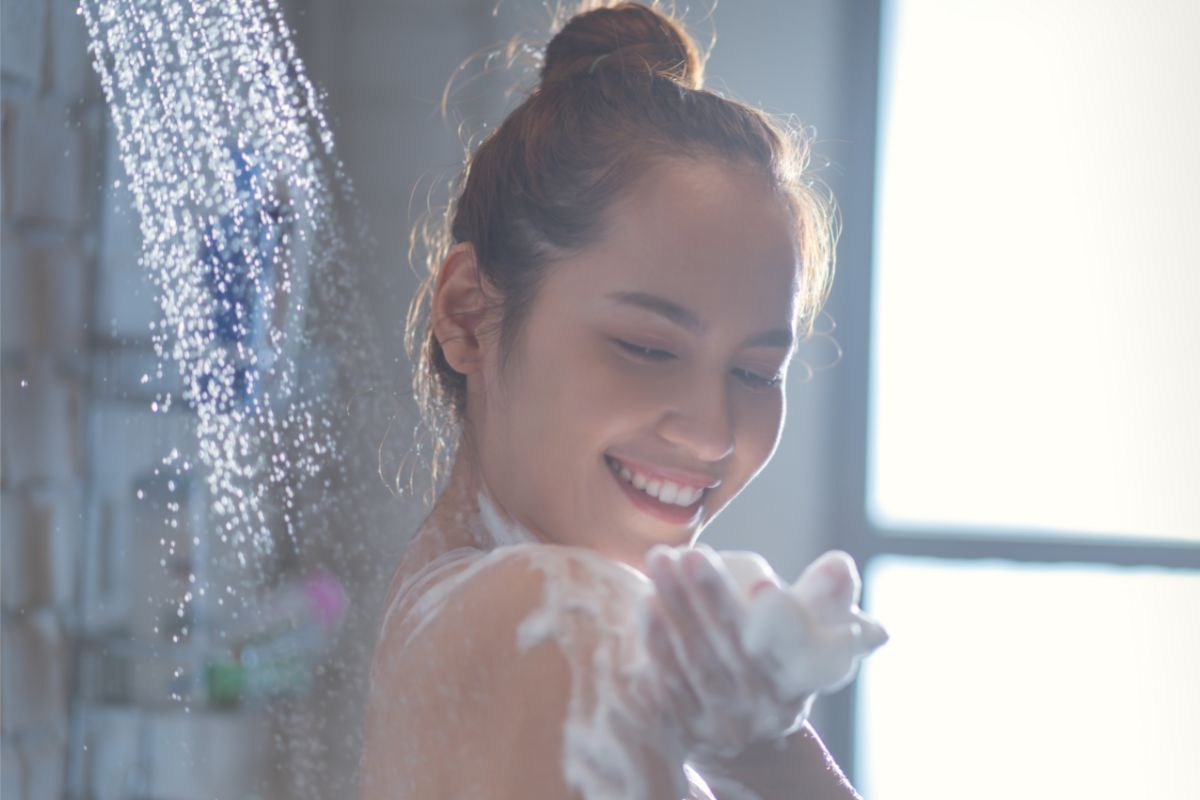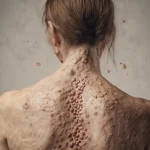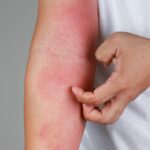The itchy and dry skin that characterizes eczema can seem to get worse after a shower. Instead of leaving the water feeling refreshed and revitalized, your skin has become uncomfortably dry, and perhaps even painful.
A bad shower routine might exacerbate eczema, but a good routine can help you care for your skin.

Using the soak and seal method allows you to lock in moisture, and clean skin is less likely to experience eczema flare-ups.
Some simple tips can help you transform your shower routine into a skin friendly experience.
Take a look at this guide to find out how to make your shower work for you.
Are Showers Or Baths Better For Eczema?
Both baths and showers are suitable for those with eczema, but showers tend to be the better choice. Those with eczema should avoid spending a long amount of time in the water, and the temptation with baths is always to soak.
But a quick bath is more beneficial than a longer shower. So, you can pick whichever washing option you prefer, as long as you pay attention to how long you spend in the water.
Have Everything At The Ready
Before you get in the water, have your (eczema-friendly) towel to hand, and your moisturizer ready to go. Shut the bathroom door to keep the moisture in.
Keep Your Time In The Water Short
Spending too much time in water can actually lead to your skin becoming dehydrated. Water strips away the sebum and the natural oils of your skin.
This sebum and oils are vital for locking in moisture. But when you spend time soaking in the water, they get washed away.
Keep showers under 10-minutes, and avoid long soaks in the bath. This way, you can get clean, without stripping the natural protections of your skin.
How often you shower or wash can also make a difference. Clean skin is less likely to suffer from an eczema flare up than dirty skin, but excess washing removes moisture.
There’s some debate still on how often eczema sufferers should wash, but a quick clean once a day is recommended.
Keep The Temperature Even
Just as too much water can be bad for your skin, so can water that’s too hot. Hot water might feel good on a cold day, but your skin hates it. It strips away the natural oils, leaving your skin dry and uncomfortable.
This doesn’t mean you have to try cold showers. Instead, keep temperatures lukewarm. Lukewarm water is around 98 degrees Fahrenheit, but you can determine the right temperature by feel.
Use The Soak And Seal Method
The soak and seal method involves getting the skin wet, and following with a moisturizer. This locks that moisture in, so your skin doesn’t have time to dry out.
To use the soak and seal method, shower quickly (less than ten minutes), using eczema friendly products.
Exit the shower or bath, and gently pat the skin until it’s damp but not soaked. Apply any prescription topical medication. Within three minutes of finishing the shower, apply moisturizer all over. Wait a few minutes for the product to sink in before dressing.
Use Your Hand, Not A Washcloth

Rather than soothing the skin, washcloths and sponges can actually lead to irritation by scraping against the surface. Create a lather in your hands, and apply any cleansers or products this way.
Swap Soap For A Gentle Cleanser
Soap has an alkaline pH, unlike skin, which is around a 5 on the pH scale. Applying soap to skin can upset the natural balance, and damage the outer layer.
Avoid soap based products, and look for gentle cleansers designed for sensitive skin. Stay away from anything containing dyes and fragrances as well, which can cause further damage.
It isn’t just the products used to clean the body that have to be considered. When we wash our hair, the shampoo and condition washes out and onto the skin.
Make sure to pick gently cleansing hair products.
Avoid using exfoliators as well. These products irritate the skin, and can cause an eczema flare up.
And Avoid Cleanser Altogether At Times
If you’re struggling with a particularly bad flare up, it might be better to avoid using cleanser altogether, or to limit usage.
Even gentle cleansers can end up having an irritating effect on the skin. Use water to get clean, before immediately applying creams and moisturizers.
Pat, Don’t Rub
When you get out of the shower or bath, don’t rub yourself down using a towel. Rubbing can cause irritation as it disturbs the skin barrier.
Instead, use a gentle patting motion to remove the worst of the water. You don’t need to completely dry yourself. Instead, leave the skin damp.
Use a clean towel to dry with, and wash it with a gentle laundry detergent that’s free from both fragrance and dye.
Apply Moisturizes With Downward Strokes
How and when you apply your moisturizer can have an effect on just how well it works. The best time to apply moisturizer is fresh out of the shower, once you’ve patted away the water and the skin is damp.
Apply any prescribed topical creams first, but make sure to use moisturizer within three minutes of exiting the shower.
To apply, use a downward stroke that moves with the direction of the hair. This can prevent any excess irritation.
With your moisturizer applied, wait a few minutes for it to sink into the skin and dry before getting dressed.
Finish With Eczema Friendly Clothing
Once your skin has dried, you’re ready to get dressed. Natural fabrics such as cotton, silk, and bamboo are breathable and comfortable for those with eczema.
Final Thoughts
Washing and bathing with eczema might sound like a lot of extra steps, but it really isn’t that much effort once you’re used to it.
Settle into the routine, and stay consistent with your usage. A little extra thought in the shower can prevent a lot of painful irritation from an eczema flare up.
- Understanding Male Reproductive Health: A Complete Guide - February 2, 2025
- Simple Healthy Skin Habits for Radiant Skin - December 6, 2024
- Unlocking the Connection Between Nutrition and Mental Health - December 3, 2024








